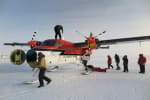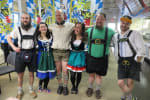Neutrino physicists spend a lot of time in the dark. As a figurative statement this reflects how difficult neutrinos are to understand, but it also reveals the literal sense that we work with experiments that do not see a lot of sun—and it’s not just the South Pole, it’s also in mines, tunnels, and deep underwater in seas and lakes. But just like a rare neutrino interaction, every so often a brief flash of light offers some new truth about the nature of our universe. […]
Week 41 at the Pole
The first planes of the season have arrived at the South Pole. Two planes landed last week, first a Basler (bearing gifts) and later a Twin Otter, shown in this image. […]
Observation of Astrophysical Neutrinos in Four Years of IceCube Data
Introduction The spectrum of cosmic rays includes the most energetic particles ever observed. The mechanism of their acceleration and their sources are, however, still mostly unknown. Observing astrophysical neutrinos can help solve this problem. Because neutrinos are produced in hadronic interactions and are neither absorbed nor deflected, they will point directly back to their source. […]
Week 40 at the Pole
The winterover crew gathered at the geographic South Pole for their annual group shot.
It was a relatively quiet week for the IceCube detector, but busy in general for the station. It’s that time of year, post sunrise, when preparations for summer arrivals are in full swing. […]
IceCube Collaboration meeting begins in Copenhagen, Denmark
The IceCube Collaboration’s fall 2015 meeting begins today at the Niels Bohr Institute in Copenhagen, Denmark. Assistant Professor Jason Koskinen and Niels Bohr Professor Subir Sarkar of the University of Copenhagen host the weeklong meeting. […]
Week 39 at the Pole
The last thing you want to forget to pack when you’re off to the South Pole for a year is … your lederhosen. Afterall, Oktoberfest is among the many things that winterovering folks celebrate at the station. […]
Week 38 at the Pole
With the sun now up, outdoor preparations for summer activity at the South Pole station will move into higher gear. Calm weather last week provided an opportunity to groom the skiway, shown in this image, where the Earth’s shadow is still visible in the sky as a blue band just above the horizon. […]
IceCube graduate student Seongjin In awarded the Korean Global PhD Fellowship
The National Research Foundation of Korea has awarded Seongjin In, a graduate student at Sungkyunkwan University (SKKU) and known as Jin within the IceCube community, with a 2015 Global PhD Fellowship (GPF). […]
Week 37 at the Pole
Sunrise is slowly coming along at the South Pole, with some refracted light showing over the horizon on clear days. The impending orange glow appears to be approaching the ICL in this image. […]
A summer of Antarctic research at UWRF
The Physics Department of UW–River Falls hosts summer internships for young college students that allow them to engage in IceCube and other polar science projects. Over the 10-week internship, they become a member of the team, where they learn to program and to tackle challenging scientific questions. And, as you will read here, they also get a chance to share their experience. […]








